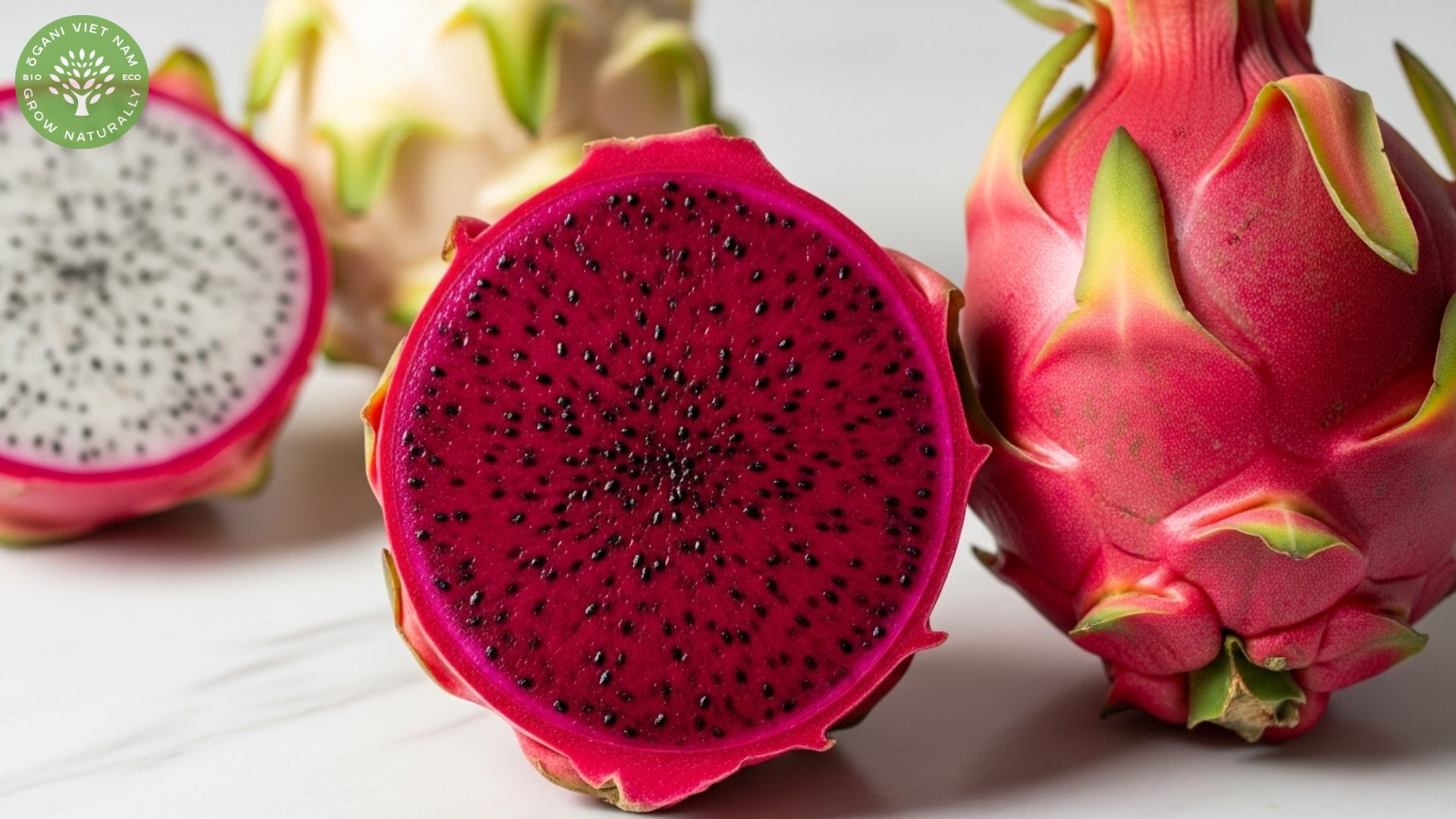
Why red dragon fruit is red is mostly because of natural stuff called betacyanins – these are strong antioxidants that make the inside really deep red. Unlike fake food coloring, this natural red not only looks nice but also is good for you.
At Ogani VN, we see a lot of people pause when they see red dragon fruit first time, thinking maybe it is colored with chemicals. But it’s really natural! After many years working with good dragon fruits, we learned some cool things about these pigments that anyone who likes fruit should know.
What makes red dragon fruit red: The science behind betacyanins
The really red color comes from a type called Hylocereus polyrhizus. This one makes a lot of betacyanins. These aren’t normal plant colors – they are a special kind with nitrogen, and not many fruits in the world have them.
Understanding what makes red dragon fruit red at the molecular level
Betacyanins work not like anthocyanins, the stuff that makes most red fruits like strawberries or cherries red. Anthocyanins can go bad and lose color fast, but betacyanins keep their bright red really well. That’s why red dragon fruit stays so red even when light hits it.
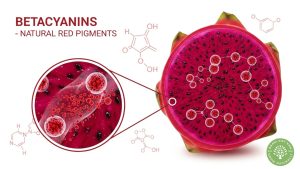
What’s really interesting is how these colors happen. The more the fruit ripens, the more betacyanins it makes. That’s why fully ripe red dragon fruits look much redder than ones that aren’t quite ready. We see that fruits picked at the right time from our trusted farmers always have the deepest, yummiest red.
The amount of betacyanin can change a lot depending on where the fruit grows. Fruits from volcanic soils with lots of minerals usually get even redder. That’s why some red dragon fruits look almost purple, and some are more bright red.
Red vs white dragon fruit: More than just color differences
A lot of people think red and white dragon fruits are just the same fruit with different colors, but it’s more than that. The red one (Hylocereus polyrhizus) has way more antioxidants because of the betacyanins we talked about.
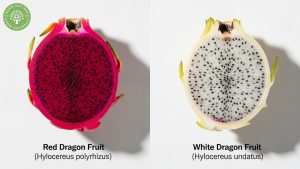
White dragon fruit like Hylocereus undatus doesn’t have the red stuff at all, so the inside is white and see-through with tiny black seeds. The taste is different too – red ones usually taste a bit stronger and kind of berry-like, while white ones are softer and more mild.
Red dragon fruit is also way better for antioxidants. Studies show red ones can have up to 10 times more betacyanins than white ones. That means they help more with inflammation and protect your cells better.
Red dragon fruits are usually smaller but denser than white ones, with more water and stronger flavor. When we pick them, we notice red ones feel heavier for their size – a good sign of quality that customers can check.
Health benefits of betacyanins in red dragon fruit
Powerful antioxidant protection
Betacyanins don’t just make the fruit look pretty – they are really good for you. They can fight harmful free radicals in your body, which helps reduce stress on your cells that can cause aging and other health problems.
Some research shows betacyanins might help lower total cholesterol and bad cholesterol (LDL) even better than a lot of other natural antioxidants. They are also good for the liver, so red dragon fruit is a smart choice if you want to take care of your liver and overall health.
Anti-inflammatory and immune support
Eating foods with lots of betacyanins, like red dragon fruit, might help lower long-term inflammation in the body. Unlike fake supplements, these natural compounds work together with other nutrients in the fruit, so your body can use them better.
The bright red color also helps the immune system, but how much your body gets can depend on things like your stomach’s pH and what else you eat. That’s why we usually suggest eating red dragon fruit as part of a balanced meal, not just by itself.
Preserving what makes red dragon fruit red during cooking and preparation
One thing people cooking at home notice is it’s tricky to keep red dragon fruit looking red in recipes. The betacyanins are usually pretty stable, but certain things when cooking can change them.
Heat is the biggest problem. High heat can break down the betacyanins, making the bright red fade to brown or purple. So it’s better to add red dragon fruit at the end of cooking or use gentle heat if you want it in warm dishes.
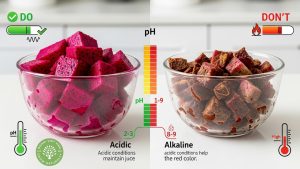
pH matters a lot for keeping red dragon fruit red. Acidic stuff (low pH) helps the red stay bright, but alkaline stuff can make it turn purple or even yellow. A little lemon juice or other mild acid helps keep the color nice in fruit salads or smoothie bowls.
When making smoothies, don’t blend too long. Too much air can make the red fade faster. Quick pulses work better. Freezing red dragon fruit can actually help keep the red strong – when it thaws, the pigments get more concentrated.
Also, betacyanins can stain other foods. This can be fun if you want natural color in desserts or drinks, but keep it in mind if you’re mixing with light-colored ingredients you want to stay clean.
How to select and identify quality red dragon fruit
What makes red dragon fruit red: Choosing fruits with optimal betacyanin content
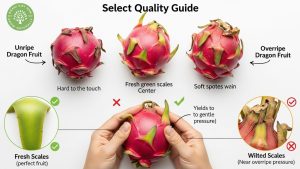
Picking good red dragon fruit isn’t just about looking at the outside. The skin should be bright pink or magenta with green “scales” that look fresh, not brown or shriveled.
A good fruit should feel a little soft when you press it, like a ripe avocado. Really hard ones need more time to ripen, and super soft ones might be overripe. Inside, the red flesh should be deep and even – pale or patchy spots usually mean it didn’t ripen properly.
Understanding freshness indicators
Fresh red dragon fruits have a light, sweet smell near the stem. If it smells sour or fermented, it’s probably overripe. The fruit should feel heavy for its size – light ones might be dehydrated or not fully developed inside.
At Ogani VN, we tell customers to pick fruits with skin that’s not damaged. Small spots are okay, but avoid fruits with soft areas, cracks, or dark patches – that usually means the inside is bad. The brightest, most red flesh usually comes from fruits that ripened fully on the plant before being picked.
Frequently Asked Questions
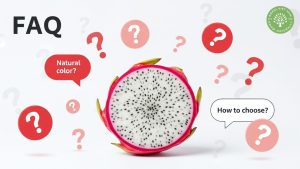
Is the red color in dragon fruit natural or fake? It’s totally natural. The red comes from betacyanin pigments in Hylocereus polyrhizus. These fruits aren’t genetically changed or colored with anything artificial.
Why are some red dragon fruits redder than others? It depends on how ripe they are, the soil, how they were grown, and when they were picked. Fully ripe fruits from mineral-rich soil usually look the deepest red.
Can I eat red dragon fruit if I have allergies? For most people, it’s safe and hypoallergenic. But if you have serious fruit allergies, check with a doctor before trying it.
Does cooking ruin the health benefits? High heat can lower betacyanin and antioxidants. To get the most benefits, eat it fresh or add it to dishes at the end of cooking.
How long does red dragon fruit stay good after cutting? Eat cut fruit within 2–3 days in the fridge. The color might fade a bit, but it’s still safe to eat.
Experience the natural beauty of red dragon fruit
Knowing why red dragon fruit is red helps us enjoy both how pretty it looks and how good it is for health. The betacyanin pigments that make it so red also give strong antioxidant benefits, making it one of the most eye-catching fruits in nature.
At Ogani VN, we love bringing you the best red dragon fruits with the brightest natural red. Whether you eat them fresh, put them in smoothies, or use them in fun recipes, knowing how to keep that red color makes your dishes look nicer and gives you more nutrition.
Want to try the natural beauty and health benefits of top-quality red dragon fruit? Come to Ogani VN stores or check our online shop to see hand-picked fruits with the reddest, most natural color. Your taste buds – and your body – will thank you for picking nature’s most colorful superfruit.
Read more:
- Smoothie Bowl Toppings with Dried Red Dragon Fruit: Pairings & Textures
- Organic Dried Mango: Your Complete Guide To Healthy Snacking
- How to Store Dried Mango & Maximize Shelf Life (Pantry, Fridge, Freezer)
- Dried Mango vs Freeze‑Dried Mango: Nutrition, Texture & Best Uses
- How to Rehydrate Dried Red Dragon Fruit (3 Methods) + What to Make with It

